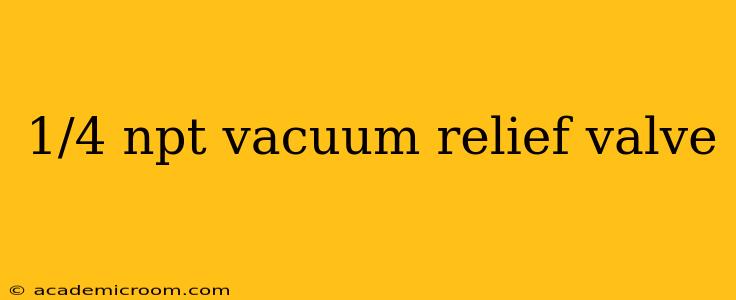Vacuum relief valves are crucial safety components in many systems, preventing the buildup of excessive vacuum pressure that can cause damage or malfunction. A 1/4" NPT vacuum relief valve, specifically, is a common size used in various applications due to its compact size and versatility. This guide delves into the specifics of these valves, addressing common questions and concerns.
What is a 1/4" NPT Vacuum Relief Valve?
A 1/4" NPT vacuum relief valve is a pressure relief device designed to automatically open when a vacuum pressure within a system drops below a predetermined setpoint. The "1/4"" refers to the nominal pipe size of the valve's connection, and "NPT" stands for National Pipe Taper—a standard tapered pipe thread used in North America. These valves typically use a spring mechanism to regulate the opening pressure, ensuring the valve opens only when the vacuum level reaches a critical point. This prevents implosion or damage to the system.
What are the Applications of a 1/4" NPT Vacuum Relief Valve?
These versatile valves find application in a broad range of industries and systems, including:
- Chemical Processing: Protecting equipment from the damaging effects of vacuum.
- Pharmaceutical Manufacturing: Maintaining system integrity and product quality.
- Food and Beverage Processing: Ensuring the safety and sanitation of equipment.
- HVAC Systems: Preventing the collapse of ductwork or other components under vacuum.
- Vacuum Packaging: Protecting packaging integrity.
- Automotive Testing: Used in various testing scenarios requiring vacuum control.
The compact size of the 1/4" NPT valve makes it ideal for applications where space is limited.
What are the Different Types of 1/4" NPT Vacuum Relief Valves?
Several types of 1/4" NPT vacuum relief valves exist, each designed for specific applications and pressure ranges:
- Spring-loaded valves: The most common type, using a spring to regulate the opening pressure. The strength of the spring determines the vacuum setpoint.
- Diaphragm valves: Utilize a flexible diaphragm to control the flow, often offering better sealing capabilities than spring-loaded valves.
- Manually operated valves: These valves require manual intervention to open or close, offering more control in specific situations.
The choice of valve type depends on factors such as the required operating pressure, the nature of the fluid handled, and the specific application demands.
How Does a 1/4" NPT Vacuum Relief Valve Work?
The operation is relatively straightforward. When the internal pressure of the system drops below the pre-set vacuum level, the spring-loaded mechanism (or diaphragm) allows the valve to open. This allows atmospheric air to enter the system, equalizing the pressure and preventing further vacuum buildup. Once the pressure rises above the setpoint, the valve automatically closes.
What are the Key Specifications to Consider When Choosing a 1/4" NPT Vacuum Relief Valve?
Several specifications are critical when selecting the appropriate valve:
- Vacuum setpoint: The vacuum pressure at which the valve will open.
- Flow capacity: The volume of air the valve can handle when open.
- Material compatibility: The valve material must be compatible with the fluid or gas within the system.
- Temperature range: The operating temperature range of the valve.
- Connection type: In this case, 1/4" NPT.
- Pressure rating: The maximum pressure the valve can withstand.
What is the Difference Between a Vacuum Relief Valve and a Vacuum Breaker?
While both manage vacuum, their functions differ slightly. A vacuum relief valve automatically opens and closes based on pressure changes, preventing the buildup of excessive vacuum. A vacuum breaker, however, is typically a manually operated valve used to deliberately break a vacuum in a system, often for maintenance or safety purposes.
How Do I Choose the Right 1/4" NPT Vacuum Relief Valve for My Application?
Selecting the right valve requires a thorough understanding of your system's needs. Consider the following:
- Maximum operating vacuum: Determine the lowest vacuum pressure your system might experience.
- Fluid or gas properties: Ensure the valve material is compatible.
- Flow rate requirements: Calculate the necessary air flow to prevent excessive vacuum.
- Environmental conditions: Account for temperature and other environmental factors.
Consulting with a valve specialist can help you choose the most appropriate valve for your specific application.
This detailed guide provides a comprehensive understanding of 1/4" NPT vacuum relief valves. Remember to always consult the manufacturer's specifications and safety guidelines when installing and operating these critical components.
